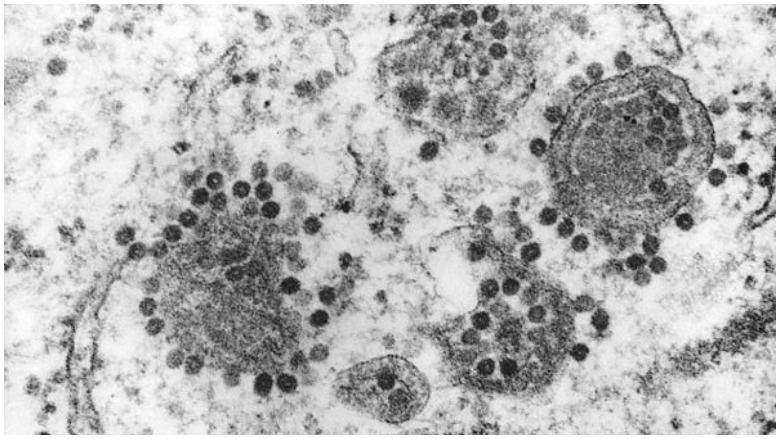
Wikimedia Commons Eastern Equine Encephalitis virus.
The Eastern Equine Encephalitis (EEE) virus is a disease transmitted by mosquitoes and birds in hardwood swamps, according to the Centers for Disease Control and Prevention (CDC). The EEE virus is fatal in horses, but not in humans.
According to the CDC, roughly a third (30%) of people who get infected with the EEE virus die and survivors still experience neurologic problems.
Mosquitoes, considered “the world’s deadliest animal” because of their tendency to carry diseases, most often transmit the virus to humans through a bite.
What Symptoms Does EEE Cause?
Once someone is bitten by a mosquito that has the virus, the appearance of symptoms can take as little four or as many as ten days to appear, according to the CDC.
The illness causes fevers, chills, malaise, arthralgia (joint paint) and myalgia (muscle pain) for 1-2 weeks and about seven out of 10 recovers, according to the CDC. When symptoms of the illness reach the central nervous system, such as vomiting, diarrhea, seizures, behavioral changes, drowsiness and coma, the fatality of EEE increases. The result is typically meningitis, which infects membranes in the brain and spinal cord, or encephalitis (infection of the brain which typically also causes severe swelling and behavioral changes).
For those for whom the disease is fatal, death usually takes place 2-10 days after symptoms appear, although even those who recover often experience long-lasting effects and die later. Those long-lasting effects include intellectual impairments, personality disorders, seizures, paralysis and cranial nerve dysfunction, according to the CDC.
There is no vaccine or antiviral treatment.
Could EEE Virus Become the Next Health Crisis?
However, according to WUSA-9, “it’s unlikely to become the next big disaster of 2020.”
The disease is very rare, and only 5-10 cases typically occur every year, according to the CDC. That’s because the CDC has said that 95% of people bitten by a mosquito with EEE won’t even get sick and if they are infected with virus (but not the disease), they receive lifelong immunity.
Additionally, there is no human-to-human spread because mosquitoes typically carry the virus from birds to humans, according to the local TV station WUSA-9.
Cases have been increasing, however, as Heavy reported earlier with a state-by-state map. The virus, which is most prevalent in the northeast, caused the most cases in 2019 and roughly 15 of the 38 people with EEE died last year.
How Can You Best Avoid the Virus?
The best way to avoid catching the disease is to avoid being bitten by mosquitoes.
According to the CDC, you can avoid being bitten by:
- Avoiding swamps in the summer months
- Installing plants, such as lavender and Citronella plants, that naturally repel mosquitoes (a list from Country Living is available here)
- Using window screens and avoid leaving windows and doors open
- Spraying EPA-registered insect repellants when in areas with a heavy mosquito presence (listed here)
- Remove or replace the water in items near the home where mosquitoes tend to lay their eggs, such as buckets and birdbaths
Some states in the northeast have also taken precautions; Connecticut shut down their campsites, according to the New York Post and in Rhode Island, the state’s philharmonic orchestra reschedules its concerts.
READ NEXT: EEE Virus Map Near Me: State-by-State List of Cases & Deaths
